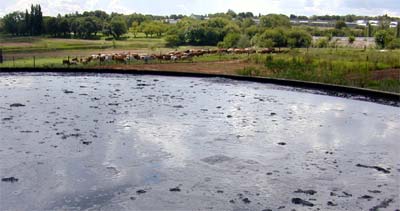

Waste treatment systems are well known sources of foul odours. The
most prevalent of these are hydrogen sulphide (H2S), ammonia
and volatile fatty acids.
Hydrogen sulphide is caused by the anaerobic digestion of sulphur
containing compounds by bacteria. The organisms produce these dissolved
sulphides and release them into their aqueous environment. Water has a
saturation point for sulphides and when the point is breached the
sulphides are liberated from the water in the form of H2S
gas.
OT200 was developed to eliminate and control malodours
originating from waste water and sludge storage lagoons. The product
works on three levels to eliminate odours.
The first is to introduce microbes that
use the malodorous compounds produced by anaerobic bacteria as a food
source for their own growth and in so doing eliminate these before they
are released into the air.
Secondly, anaerobic bacteria that are
responsible for the majority of malodours, grow and reproduce more
slowly than the facultative aerobes present in OT200/400. This
means that if the aerobes can be applied in sufficient quantities, then
they will out compete the sulphide producing bacteria for food.
Thirdly, the microbes present in our
product will work to reduce organic waste in the system and in so doing
affect the anoxic environments that support the growth of the sulphate
reducing bacteria.
Applications
- Malodours are formed in areas of the sewer where
anaerobic conditions occur. The are generally characterised by areas
of low flow like rising mains, pumping ‘wet wells’ or sumps and
storage tanks used to balance the sewerage plant.
- Food processing waste handling lagoons
- Animal waste sludge and storage basins
- Domestic septic tanks and grease traps
- Effluent ponds in piggeries, poultry farms,
abattoirs and dairy producers
- Sewage pump stations and sludge handling
facilities.
Benefits
- Eliminate the unpleasant odours and the impacts
of these on the public.
- Reduces hydrogen sulphide (H2S)
induced corrosion of metal and concrete in waste treatment works. (H2S
is a precursor for the formation of sulphuric acid)
- Removes already formed H2S and
ammonia compounds from the system.
- The product reduces foul odours at source and
does not mask the symptoms.
- Improves safety by reducing H2S which
is considered toxic.
- Reduces BOD and the composting of organic
wastes.